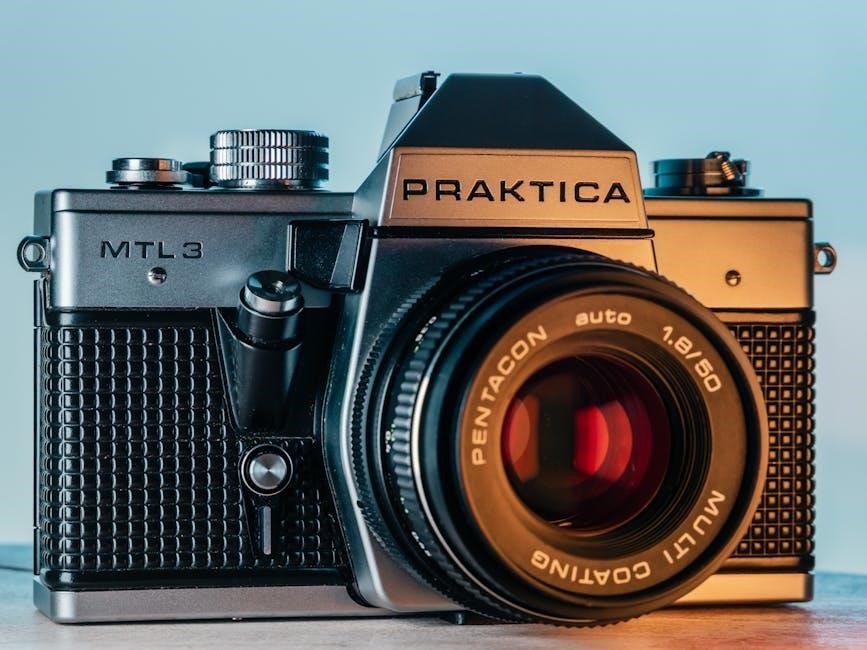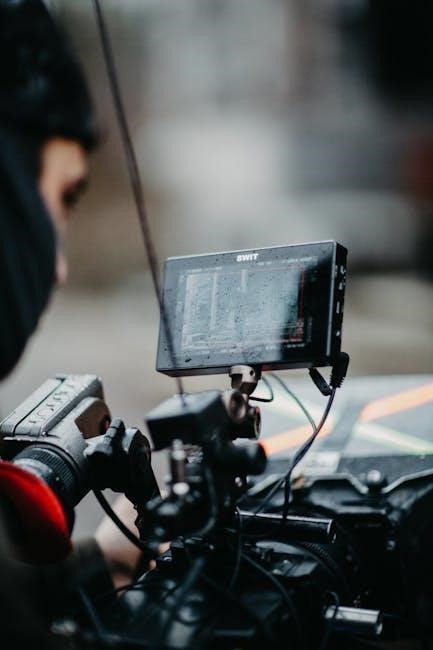Definition of Camera Shots
A camera shot is a series of frames that runs for a specific length of time, defined by a guide to camera shots pdf, which outlines the various shot types and terminology for beginners in video and animation.
The definition of camera shots is crucial in understanding the language of filmmaking and photography, as it provides a common vocabulary for directors, cinematographers, and other crew members to communicate their vision.
A guide to camera shots pdf typically includes definitions of shot sizes, such as extreme long shot, long shot, medium shot, and close-up shot, as well as camera angles and movements.
This information is essential for creating a shot list, which is a document that outlines the specific shots to be captured during a film or photography shoot.
By understanding the definition of camera shots, filmmakers and photographers can effectively plan and execute their shots, resulting in a visually appealing and engaging final product.
The guide to camera shots pdf is a valuable resource for both beginners and experienced professionals, providing a comprehensive overview of the different camera shots and how to use them to tell a story.
Importance of Camera Shots
The importance of camera shots cannot be overstated, as they play a crucial role in storytelling and visual communication, as outlined in a guide to camera shots pdf.
Camera shots help to establish the mood and atmosphere of a scene, and can be used to convey emotions and ideas to the audience.
A well-crafted shot can draw the viewer’s attention to specific details, create tension or suspense, and guide the narrative flow.
The effective use of camera shots can also enhance the overall visual aesthetic of a film or video, making it more engaging and immersive for the viewer.
Furthermore, camera shots can be used to create a sense of continuity and cohesion, tying together different scenes and storylines.
By understanding the importance of camera shots, filmmakers and photographers can create a more impactful and memorable visual experience for their audience, as discussed in a guide to camera shots pdf.
This knowledge is essential for creating high-quality visual content that resonates with viewers.

Types of Camera Shots
Various shot types exist, including extreme long, long, and medium shots, as outlined in a guide to camera shots pdf using
- tags for listing.
Extreme Long Shot
An extreme long shot is a type of camera shot that captures a very wide view of the scene, often showing the subject from a great distance. This type of shot is typically used to establish the setting or location of the scene, and can be used to create a sense of scale or grandeur. In a guide to camera shots pdf, the extreme long shot is often defined as a shot that includes the entire scene, from the horizon to the foreground; The shot is usually taken from a high angle, looking down on the scene, and can be used to create a sense of detachment or objectivity. The extreme long shot is an important part of the cinematographer’s toolkit, and is often used in conjunction with other types of shots to create a visually appealing and engaging film. The shot can be used to show the relationship between the subject and the environment.
Long Shot
A long shot is a type of camera shot that captures the subject from head to toe, while also showing some of the surrounding environment. This type of shot is often used to establish the setting or location of the scene, and can be used to create a sense of context or atmosphere. In a guide to camera shots pdf, the long shot is typically defined as a shot that includes the subject’s full body, as well as some of the background or foreground. The shot is usually taken from a neutral angle, neither too high nor too low, and can be used to create a sense of balance or stability. The long shot is a versatile type of shot that can be used in a variety of contexts, and is often used to introduce a character or setting. It can also be used to show the subject’s movement or interaction with the environment.
Medium Shot

A medium shot is a type of camera shot that frames the subject from the waist up, providing a balance between the subject’s face and body. This type of shot is often used to capture dialogue or interactions between characters, and can be used to create a sense of intimacy or connection. In a guide to camera shots pdf, the medium shot is typically defined as a shot that includes the subject’s upper body, from the waist to the head. The shot is usually taken from a slightly angled perspective, and can be used to create a sense of depth or dimension. The medium shot is a commonly used type of shot in film and television, and is often used to establish a character’s personality or emotions. It can also be used to show the subject’s reactions or responses to their environment or other characters. The medium shot is a versatile type of shot that can be used in a variety of contexts.

Camera Shot Templates and Guides
Using a guide to camera shots pdf helps filmmakers create shot lists with
- tags for organization and planning purposes effectively.
Shot List Template PDF
A shot list template pdf is a valuable resource for filmmakers, providing a structured approach to planning and organizing camera shots. Using a shot list template pdf, filmmakers can ensure that all necessary shots are captured, and that the filming process runs smoothly. The template typically includes columns for shot type, camera angle, and lighting requirements, making it easy to visualize and plan the shoot. With a shot list template pdf, filmmakers can also easily share their vision with the rest of the production team, including the director, cinematographer, and camera operators. This helps to ensure that everyone is on the same page, and that the final product meets the desired creative goals. By using a shot list template pdf, filmmakers can save time, reduce errors, and create a more efficient and effective filming process. This template is an essential tool for any filmmaker.
Guide to Basic Camera Shots
A guide to basic camera shots is essential for beginners in video and animation, providing a comprehensive overview of the different types of camera shots. The guide covers key concepts such as shot size, camera framing, and movement, helping to establish a strong foundation in cinematography. By understanding the basics of camera shots, filmmakers can effectively communicate their vision and create a visually appealing final product. The guide to basic camera shots is often presented in a pdf format, making it easily accessible and downloadable. This resource is perfect for students, independent filmmakers, and anyone looking to improve their filmmaking skills. With a guide to basic camera shots, filmmakers can learn how to use different camera angles and movements to tell a story and convey emotion, taking their filmmaking to the next level and creating engaging content for their audience.

Camera Movements and Angles
Camera movements and angles enhance storytelling using
tags for descriptions and
- lists for techniques.
Point of View Shot
A point of view shot is a camera angle that shows what a character is seeing, using
tags to describe the scene and
- lists to outline the benefits.
This type of shot is essential in filmmaking as it helps the audience connect with the character’s perspective, creating a more immersive experience.
The point of view shot is often used in conjunction with other camera angles, such as the over-the-shoulder shot, to create a sense of continuity and flow.
By using a point of view shot, filmmakers can build tension, create suspense, and guide the audience’s attention, making it a powerful tool in storytelling.
The guide to camera shots pdf provides a detailed analysis of the point of view shot, including its definition, examples, and best practices for use in filmmaking, using
tags for headings and
lists for step-by-step instructions.
Filmmakers can use this guide to improve their understanding of the point of view shot and how to effectively incorporate it into their films, creating a more engaging and captivating experience for their audience.
The point of view shot is a fundamental element of filmmaking, and mastering its use can elevate a film from good to great, making it an essential topic to explore in the guide to camera shots pdf, with ![]() tags for visual examples.
tags for visual examples.
Camera Angles and Definitions
Camera angles and definitions are crucial in filmmaking, and the guide to camera shots pdf provides a comprehensive overview of the different types of camera angles, using
tags to compare and contrast.
The pdf guide includes definitions of various camera angles, such as high angle, low angle, and eye-level angle, and explains how each angle can be used to create a specific mood or effect, with ![]() tags for visual examples.
tags for visual examples.
The guide also discusses the importance of camera movement and how it can be used to add depth and interest to a scene, using
lists to outline the benefits.
By understanding camera angles and definitions, filmmakers can create a visually appealing and engaging film that captures the audience’s attention, and the guide to camera shots pdf is a valuable resource for learning about these essential filmmaking concepts, with tags for further reading.
The pdf guide is a must-have for any filmmaker looking to improve their craft, and its comprehensive coverage of camera angles and definitions makes it an indispensable tool, using
tags for headings.
Filmmakers can use this guide to improve their understanding of the point of view shot and how to effectively incorporate it into their films, creating a more engaging and captivating experience for their audience.
The point of view shot is a fundamental element of filmmaking, and mastering its use can elevate a film from good to great, making it an essential topic to explore in the guide to camera shots pdf, with
Camera Angles and Definitions
Camera angles and definitions are crucial in filmmaking, and the guide to camera shots pdf provides a comprehensive overview of the different types of camera angles, using



